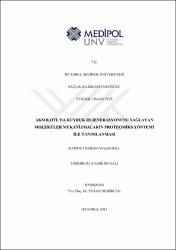Aksolotl'da kuyruk rejenerasyonunu sağlayan moleküler mekanizmaların proteomiks yöntemi ile tanımlanması
Künye
Avşaroğlu, M. E. (2017). Aksolotl'da kuyruk rejenerasyonunu sağlayan moleküler mekanizmaların proteomiks yöntemi ile tanımlanması. (Yayınlanmamış yüksek lisans tezi). İstanbul Medipol Üniversitesi Sağlık Bilimleri Enstitüsü, İstanbul.Özet
Ambystoma mexicanum(aksolotl) su semenderleri sınıfından yaşamı boyunca neotenik özelliğe sahip olan bir canlıdır. Deneysel araştırmalarda sahip olduğu yüksek rejenerasyon yeteneği ve kansere karşı gösterdiği dayanıklılık sebebiyle model organizma olarak kullanılmaktadır. Aksolotlar maruz kaldıkları hasarlar sonrası iç organlarını, ekstremitelerini, merkezi sinir sistemlerini ve omuriliklerini eski fonksiyonel özelliğini tekrardan gösterecek şekilde yenileyebilmektedirler. Sahip oldukları bu özelliğin moleküler ve hücresel sinyal mekanizmaları geçmiş dönemlerde teknolojik imkanların yetersiz olması sebebiyle tam olarak anlaşılamamıştır. Günümüzün çığır açan omiks teknolojisi insanlığa bu durumun üstesinden gelebilecek imkanlar sunmaktır. Omiks teknolojisinin en çok çalışılan dallarından birisi olan proteomiks teknolojisi; hücresel olayların ve etkileşimlerin protein düzeyinde anlaşılması için kullanılmaktadır. Bu çalışmada aksolotl canlısının sahip olduğu rejenerasyon yeteneğini anlaşılması için canlının omurilik içeren kuyruk bölgesi ampüte edilmiştir. Rejenerasyon süresince 0. gün, 1. gün , 4. gün ve 7. gün olacak şekilde farklı zaman aralıklarında alınan örneklerden hücresel olaylar ve etkileşimlerde görev alan proteinler proteomiks yöntemi ile tanımlanmış, aksolotl proteom veritabanı genişletilmiştir. Anlamlı düzeyde değiştiği tanımlanan proteinler içerisinden omurilik yenilenmesinde görev alabilecek sinirsel görev ile ilgili proteinler seçilerek gen ontoloji analizleri yapılmış; moleküler fonksiyon süreçlerinde, hücresel bileşen olarak katıldıkları süreçlerde ve biyolojik süreçlerde aldıkları görevler analiz edilmiştir. Ambystoma mexicanum(Mexican axolotl) is an aqueous salamander that posses neoteny during whole life. Axolotls are useful experimental models in laboratories due to their unique regeneration capacity and resistance to cancerous diseases. Axolotls can regenerate their missed extremities, internal organs, brains, and spinal cords with full recovery of function after damages or amputations. The molecular and cellular signaling mechanisms of this speciality they possess have not been fully understood in the past due to the insufficient technological possibilities. Today's groundbreaking omics technology provides humanity with the opportunities that can come from its superiority. One of the most studied branches of Omics technology is proteomics which is using for understanding cellular events and interactions at protein level. In order to understand the regenerative ability of experimental model axolotl in this study, we amputated the tail containing spinal cord region to observe cellular events and interactions during tail regeneration in different time intervals. According to our results, axolotl proteomics database was expanded by identifying proteins detected on day 0, day 1, day 4 and day 7 samples by proteomics method. By using significantly changed proteins, neuron related proteins that can serve in spinal cord regeneration were selected. Selected neuronal proteins were analyzed in gene ontology analysis that contain molecular functional processes, cellular components, and biological processes.
Koleksiyonlar
- Tez Koleksiyonu [1159]


















